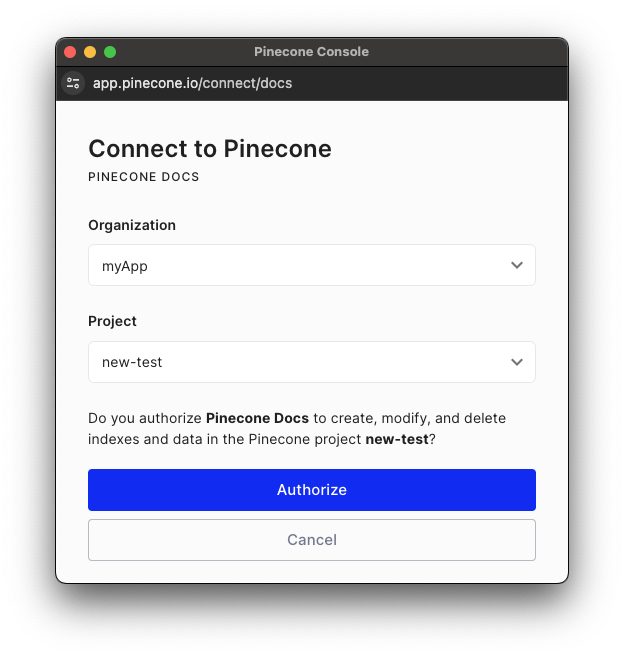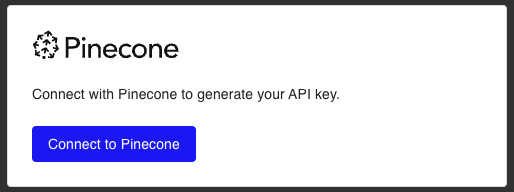Only organization owners can add or manage integrations.
Create an integration ID
Create a uniqueintegrationId to enable usage of the Connect to Pinecone popup and widget:
-
On the the Integrations tab in the Pinecone console, click the Create Integration button.
The Integrations tab does not display unless your organization already has integrations. Follow this link to create your first integration.
-
Fill out the Create integration form:
- Integration name: Give your integration a name.
-
URL Slug: This is your
integrationID. Enter a human-readable string that uniquely identifies your integration and that may appear in URLs. Your integration URL slug is public and cannot be changed. - Logo: Upload a logo for your integration.
-
Return mechanism: Select one of the following return methods for the generated API key:
- Web Message: Your application will receive the Pinecone API key via a web message. Select this option if you are using the @pinecone-database/connect library. The API key will only be provided to the allowed origin(s) specified below.
- Copy/Paste: The API key will display in the success message, and users will need to copy and paste their Pinecone API keys into your application.
- Allowed origin: If you selected Web Message as your Return mechanism, list the URL origin(s) where your integration is hosted. The origin is the part of the URL that specifies the protocol, hostname, and port.
- Click Create.
Anyone can create an integration, but becoming an official Pinecone partner can help accelerate your go-to-market and add value to your customers.
Custom object
Once you have created yourintegrationId, you can create a custom object, like a button or link, that loads a Connect to Pinecone popup that displays as follows:

ConnectPopup function can be called with either the JavaScript library or script. The JavaScript library is the most commonly used method, but the script can be used in instances where you cannot build and use a custom library, like within the constraints of a content management system (CMS).
The function includes the following required configuration option:
-
integrationId: The slug assigned to the integration. IfintegrationIdis not passed, the widget will not render.To create a uniqueintegrationId, fill out the Create Integration form.
open: A function that opens the popup. Suitable for use as an on-click handler.
Pre-built widget
The pre-built Connect widget displays as follows:
integrationId, you can embed the Connect widget multiple ways:
- JavaScript library (
@pinecone-database/connect) or script: Renders the widget in apps and websites. - Colab (
pinecone-notebooks): Renders the widget in Colab notebooks using Python.
JavaScript
To embed the Connect to Pinecone widget in your app or website using the@pinecone-database/connect library, install the necessary dependencies:
Shell
connectToPinecone function. It displays the widget and calls the provided callback function with the Pinecone API key, once the user completes the flow.
The function includes the following required configuration options:
-
integrationId: The slug assigned to the integration. IfintegrationIdis not passed, the widget will not render.To create a uniqueintegrationId, fill out the Create Integration form with Pinecone. -
container: The HTML element where the Connect widget will render.
JavaScript
HTML
Colab
To embed the Connect widget in your Colab notebook, use thepinecone-notebooks Python library: